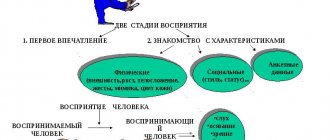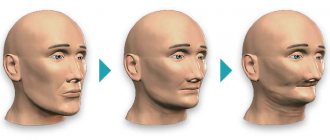German psychiatrist Karl Leonhard introduced the concept of accentuated personality in 1968 and, with it, created one of the first character classifications. The scientist identified twelve pure types and divided them into three groups. Knowing and understanding these types will help you better understand people and understand yourself. Having an idea about a person and his character, you will be able to correctly adjust further communication so that it is pleasant for both you and your interlocutor.
Accentuation refers to individual traits that can develop into a pathological state. K. Leonhard, calling personality accentuated, does not consider it pathological. Otherwise, any deviation from the middle would be a pathology. Do not forget about individuals with bright character traits who are not mentally ill.
Table of contents
- Four types of character according to Leonhard Demonstrative (hysterical) personalities
- Pedantic (anankast) personalities
- Stuck (paranoid) individuals
- Excitable (epileptoid) personalities
- Hyperthymic (hypomanic) personalities
Four types of character according to Leonard
Let's move on to the first group, which contains four types depending on society: demonstrative, pedantic, stuck, excitable. That is, these are four types of character. I note that in the headings I indicated the names in brackets - these are the names of the extreme forms, i.e. if this type is strongly expressed, then it is called this way. In the process of describing the types, I used these two concepts, which differ in “degree of severity,” as synonyms, which is probably incorrect. Although Karl Leonhard himself willingly replaced them interchangeably, at the same time, their interchangeability created contradictions in his own judgments.
What are character accentuations
The term “accentuation” was introduced by the famous German psychologist Karl Leonhard in the 60s of the 20th century. He was involved in the development of various methods of personality diagnostics. And in the end, he revealed a whole list of accentuations, that is, types of manifestation of pronounced personality traits. Both its strengths and its most vulnerable. As an example, Leonhard suggested considering the types of accentuations using the example of literary heroes.
In Leonhard's theory, accentuation manifests itself during the formation of a person's personality. You can see it most often in teenagers. In adulthood, in order to see one or another form of manifestation of accentuations, special conditions and reactions to certain life circumstances are needed. At this moment, three main signs appear by which it can be distinguished:
- impact on all areas of life
- continuity in time
- social maladjustment.
Depending on a person’s temperament, accentuations can be divided into obvious and hidden. Latent ones almost never show up in real life. And obvious ones can only be noticed during extraordinary and force majeure situations. In his theory, Leonhard considered the 12 most frequently occurring accentuations. They can be divided by temperament, character and personal level.
Demonstrative (hysterical) personalities
With pronounced accentuation, this type is called hysterical. The main essence of this character: the ability to repress. For example, a hysterical person is able to stick needles into his skin and not feel pain, i.e. a hysteric is able to displace physical sensations from consciousness.
As for the ability to deceive, they are also doing well here. Many people are betrayed by external manifestations when they are crafty. Hysterics are able to displace the thought of deception from the mind and believe in what they say. Why will they blush if for someone they consider a lie to be the truth? Children can deceive without realizing that they are liars; by the way, little liars and gossips can most likely be classified as the demonstrative type.
Demonstrative personalities, unlike other types, are more adaptable. While playing a role, the hysteric completely gets used to it and even an unforeseen circumstance is not able to unsettle him.
It was said earlier that demonstrative individuals are capable of repression and their behavior may seem unconscious and aimless. This is wrong. Demonstrative individuals first set a goal for themselves, and consciously, and further actions can already proceed mechanically. And from this conclusion follows the following characteristic feature: thoughtlessness of actions. As Karl Leonhard further notes: hysterics are ready to do anything (all methods are good) to achieve their goal. Even further, the doctor Leonhard writes: “As you know, hysterics are very concerned about the impression they make. However, they are not able to think about their course of action in advance.” Apparently, in this context, he uses the word “hysterics” as a form of character that has gone beyond the boundaries of normality. They are cunning in their inventions, but this cunning is easy to expose, since, striving for a goal, such people indiscriminately use any means, continues Karl Leonhard. – If a hysteric even has a thought about the possibility of exposure, he will immediately push it out, because the future is foggy, and the demonstrative type always lives in the moment.
Hysterics, like other individuals, want to find a way out of troublesome situations, get away from unwanted work, earn material resources, and so on. Their difference from others in achieving these goals lies in the methods peculiar to them.
Demonstrative personalities love attention. People's gazes turned to the side amuse their vanity. Even disapproving glances satisfy hysterics. This does not mean that all such individuals crave attention. This behavior can be explained by the lack of inhibition (to which Karl Leonhard often refers later).
Hysterics for the most part believe that they are not being treated fairly.
Earlier we talked about the negative side of this personality, now let's move on to the positive traits. Firstly, without demonstrative individuals there would be no balance in society. Such personalities are needed in many professions where it is necessary to adapt to people, for example, in the service sector (and not only there). In family life, demonstrative individuals are able to smooth out relationships with difficult people due to their adaptability. We shouldn’t belittle the artistic abilities of this kind of people, because this is also a positive trait?
Relationship
As already mentioned, this accentuation is too sensitive, which is why partners usually have no time to be bored in relationships.
Such people are amorous, passionate and romantic. Frequent mood swings prevent you from relaxing and experiencing peace and satisfaction in contact with them. Which is impossible to predict, and, moreover, to somehow contain or control.
But bright, sincere feelings directed towards lovers make it possible to turn a blind eye to all the above shortcomings.
Those who so lack attention and care, loud declarations of love. For those who strive for dramatic relationships, violent quarrels and reconciliations, the affectively exalted type is ideal.
If the partner decides to end the relationship, he may become intrusive. Believing that you have the power to return everything to its place and make you fall in love with yourself again. This simply requires a lot of effort.
In general, not everyone is able to withstand frequent mood swings, which is why exalted people are mostly lonely, especially in old age.
The teenage period is difficult, since girls and boys at that age suffer from unrequited love.
They may even refuse to eat, losing their appetite due to anxiety. They cry into their pillows at night and don’t want to communicate with anyone, reacting sharply to any attempts to provide them with support.
Pedantic (anankast) personalities
With pronounced accentuation, this personality is called anankast. In ancient Greek mythology, Ananka, the goddess personifying inevitability or fate. In philosophy, this term means “necessity.” The first and most important thing that distinguishes anankasts from hysterics is their weak ability to repress. That is, demonstrative individuals quickly make a decision, while pedantic tendencies delay the answer, even if the “verdict” has already been made. Karl Leonhard explains this inhibition by the fact that anankasts are not able to repress doubts and this is what slows down their actions in general. Pedants can be called indecisive, and hysterics can be called frivolous.
The consciousness of pedantic individuals is still capable of repression if the decision is not of fundamental importance.
For the most part, damage is caused mainly only to the individual and subject to the severity of this trait. In the case of accentuation, the anancast has problems making decisions; when in doubt, he double-checks several times. This excessive control causes people to fall behind their peers. It is quite possible to compensate for this shortcoming with increased conscientiousness, but more on that later. This behavior will complicate professional and everyday life, as a result of which the joys of life are reduced.
In their work activities, pedants show a conscientious attitude to work, which, of course, is confirmed by facts. True, a responsible business can have a certain burden on an anancaste, because due to his uncertainty, it will be difficult for him to make an important decision.
If they deviate from the norm, pedantic individuals may worry too much about their health. Naturally, with moderate manifestations, this can be considered a positive trait. By the way, some situations can lead a person to hypochondria.
According to the observation of Karl Leonhard, pedantic individuals are extremely neat, which, of course, can be considered a positive trait. Pedants are not prone to spontaneously changing jobs because of some trifles. Often, pedantic individuals work in one place for a long time, and maybe their entire lives. This last remark can be seen as both positive and negative.
The line between normality and pathology
Trying to independently assess the degree of their own or someone else’s adequacy, people often wonder where the line between normal and pathological psyche and behavior lies. Various accentuations of character are defined as an extreme degree of clinical norm on the border with pathology.
In the second half of the last century, namely in 1968, the German psychiatrist K. Leonhard introduced the concept of “accentuation”. He defined it as abnormal, overly enhanced individual personality traits.
Nine years later, in 1977, the Soviet scientist A.E. Lichko proposed using a more precise and narrow term “character accentuation.” It was these two scientists (K. Leongrad and A. E. Lichko) who made an invaluable contribution to the science of psychology, developing close, complementary concepts and classifications of accentuations.
Character accentuation is the excessive expression of certain traits. Accentuation is a sign of disharmony and imbalance in a person’s inner world.
When some character traits are too hypertrophied and pronounced, while others are suppressed, the individual becomes vulnerable to certain psychogenic influences and experiences difficulty maintaining a normal lifestyle.
Excessive emphasis and sharpness of certain character traits is perceived by a person and his environment as a kind of psychological problem that interferes with life, and therefore is mistakenly classified as a mental disorder.
Stuck (paranoid) individuals
With pronounced accentuation, this type is called paranoid. Its basis is the stability of affect (a state of strong arousal). That is, a paranoid person gets “stuck” on his feelings, thoughts, and so on. A stuck person can be in a state of passion for a long time and any reminder of what happened brings them back to their initial emotions.
From the above, a characteristic feature of stuck individuals follows: vindictiveness and rancor. Paranoid people are also sensitive and touchy. Therefore, having identified such a character in your interlocutor, do not touch his pride and honor.
If successful, stuck individuals may become arrogant and self-confident. Like hysterics, paranoids are seen as vain people. Stuck individuals often become suspicious when society prevents them from realizing selfish goals.
Karl Leonhard noticed that in a stuck person, in the case of constant attacks from the outside, hatred towards the offender increases and at the same time, the affect that was discussed at the beginning is weakened, i.e. the personality is “tempered.”
What is interesting about stuck individuals is that they are equally likely to become both “bad” and “good” citizens. The pole in which paranoids will be depends on their own development and the influence of society on them. So, if an ambitious person achieves significant results and stands out from others, then the development of such a character follows a positive path. If a paranoid person does not play according to the rules of society, then against such a person, the latter may rebel, as a result of which suspicion may develop.
Since stuck individuals have a weak ability to repress, they need to gain real recognition in order to be proud of themselves. This is how ambition appears, which can be a driving force.
Excitable (epileptoid) personalities
With pronounced accentuation, this type is called epileptoid. Excitable individuals are not controllable enough. Epileptoids are guided mainly by instincts.
The reactions of excitable individuals are impulsive. They rarely hide their irritation. Epileptoids, unlike anankasts, are prone to frequent job changes. Due to the insufficient development of the level of thinking, excitable individuals are not predisposed to exchange opinions, and in case of disputes, to arguments. And this leads to argumentation in another way: demonstration of physical force and assault.
Excitable individuals do not “explode” over trifles; they accumulate their anger, which comes out at a critical moment. Epileptoids are prone to accumulation of affect.
Karl Leonhard noticed slowness and heaviness in them. He, during a conversation with excitable individuals, noticed that even simple questions can cause difficulty. If you give such a person the opportunity to speak, then their thoroughness will be clearly noticeable (great detail in what is described; due to a disorder of thinking, departure from the goal). By heaviness we mean difficulty in switching the psyche, i.e. excitable individuals find it difficult to build logical chains. This can lead to pedantry.
Unlike other types, excitable individuals are much more difficult to educate. They are more prone to gluttony and alcohol. You can often find epileptoids among alcoholics.
The behavior of excitable individuals, as well as demonstrative ones, can be explained by the lack of inhibitions. Epileptoids are often called heartless due to a lack of understanding of this type of people. Karl Leonhard, as a psychiatrist, often met such individuals and from this experience explains the reasons for their evil deeds: “Although an excitable person who committed gross violence is often characterized as heartless, soulless, and cruelty is considered the cause of the crime, such an assessment is based on a misunderstanding of these people. Their acts of violence are caused not by callousness, but by affective tension (stress). In a calm state, these people are affectionate, care about their children, love animals and are often ready to provide any help. These good feelings of the social order, just like the bad ones, do not experience inhibition. However, social duty of the highest order is, in general, an alien concept to them. They don’t realize that you can’t skip class, that you can’t get incredibly drunk, that missing at least one day from work is allowed only for a very good reason, that the employee is obliged to report to the boss.”
As a person matures, self-control increases, so excitable individuals become more restrained. And only under strong tension does self-control disappear.
Personality diagnostic methods
Leonhard considered observation and conversation to be the most reliable diagnostic methods. During a personal conversation, the scientist should not study verbal information coming from the patient, but focus on his facial expressions and changes in voice intonation. Studying the patient’s behavior at work, in a relaxed home environment, and in communication with other people, according to Leonhard, provides comprehensive information about the characteristics of his personality.
However, it is not always possible to carefully monitor patients even in a hospital setting. In this case, working with G. Šmishek’s questionnaire will come to the rescue.
The text of the questionnaire, the key for processing answers, a detailed description of individual scales and combinations can be found in the book by Yu.V. Kortneva “Diagnostics of a current problem. Leonhard-Smishek technique."
As a person grows up and his personality develops, bright accentuated features smooth out. By adapting to the demands of the social environment, the individual learns to control his natural temperament. As a rule, Leonhard’s character typology is used when working with teenagers whose character has not yet been completely established.
Six types of temperament according to Leonard
Four types of character were previously discussed. He (character) determines the direction of a person’s interests and the form of reaction. Temperament is a set of innate human properties, on its basis character is formed and developed, and the pace and depth of emotional reactions also depends on it (temperament). Karl Leonhard does not see a clear distinction between these two concepts.
Hyperthymic (hypomanic) personalities
With pronounced accentuation, this type is called hypomanic. Characterized by high spirits and talkativeness. Thought racing (constant change of thoughts) is a common occurrence for hyperthymic individuals. They always look at life optimistically and crave activities that lead them to success at work or in creativity. Due to deviations from the main idea (due to jumping ideas), hyperthymic individuals have many associations, and this is a direct path to creative thinking.
Hyperthymic individuals are called the life of the party; they are excellent conversationalists and can talk endlessly.
If this type is strongly expressed, then problems may lurk here: frivolity, violation of ethical standards. A person can take on a lot and not finish it. And many ideas may lead to projectism.
Hyperthymic temperament, with mild manifestations, is the norm.
Affectively labile (cyclothymic) personalities
With pronounced accentuation, this type is called cyclothymic. Labile – in the context of the note: mobile, unstable. This temperament combines the previous two. Affectively labile individuals are characterized by a change of state from one extreme to the other, i.e. from hyperthymic to dysthymic position and vice versa. Sometimes such a change in mood is spontaneous, which is worth taking into account. A good mood can make you want to chat, while sad events can make you feel depressed and slow in your thinking.
Cyclothymic individuals in a cheerful society can be the center of attention and play to the public, but in a serious circle of people they are likely to withdraw into themselves.
Karl Leonhard refutes the idea that the hereditary combination of hyperthymic and dysthymic temperament results in an affectively labile personality. With such compatibility, it is more likely to obtain a syntonic (consonant, coordinated) temperament, which is characterized by calmness and evenness of mood. “This observation is of interest primarily for those who are inclined to see something fundamentally negative in psychopathy (mental disorder). – Karl Leonhard finishes his thought. “Meanwhile, two psychopathy, put together, can result in normality.”
Affectively exalted personalities
The name, despite its pronounced accentuation, is not exactly given by Karl Leonhard in his work. “The affectively exalted temperament, when it approaches psychopathy in severity,” writes Dr. Leongard, “could be called the temperament of anxiety and happiness.” Exaltation is enthusiasm, inspiration, excitement.
Affectively exalted individuals react very violently to any situation. They easily move into an enthusiastic state from a joyful event and into despair from sad situations. At first I wanted to write that this type is too sensitive, but I did not find Karl Leonhard using this definition to address affectively exalted individuals. This definition will be used to describe emotive personalities, which will be discussed further.
Activities in which it is necessary to reveal creative potential can captivate an exalted personality. Pity for people, extreme impressionability - this also characterizes this temperament. Alarmists can be classified as exalted individuals.
Karl Leonhard believes that in order to write poetry and other artistic activities, it is necessary to be able to give in to a high intensity of emotional experiences. Without people with an affectively exalted temperament, we would probably be left without many representatives of the creative professions.
Characteristic typical reactions
Each type of accentuation has its own way of emotional response. A study was conducted that allowed us to determine the following patterns:
- The hyperthymic type uses positive refocusing, positive reappraisal, and focusing on planning.
- The stuck type tends to blame others when failures occur.
- The emotive type resorts to self-blame and rumination.
- The anxious type chooses to ruminate, catastrophize, and blame others.
- The cycloid type resorts to rumination.
- The demonstrative type chooses positive refocusing.
- The dysthymic type chooses rumination and catastrophizing.
- Other types do not have pronounced stereotypical ways of experiencing negative situations.
I will definitely tell you more about the methods of emotional response (types of behavior in a negative situation) in another article.
Anxious or fearful individuals
Such individuals often become scapegoats. They may be afraid of the dark, dogs, other children and much more. An anxious person who has matured is more difficult to pick out from the crowd; they become less fearful, but in an argument their essence quickly becomes apparent; they are simply unable to defend their point of view.
Karl Leonhard attributes to them anankastic timidity, i.e. simply lack of self-confidence.
Fearful individuals may try to hide their nature through rude or defiant behavior. But again, such a temperament will quickly manifest itself.
Shmishek's technique
Hans Schmishek's method suggests taking a questionnaire to determine the type of accentuation. The test taker needs to answer 97 statements. There are only two possible answers: “Yes” and “No” (regarding how true the statement is in relation to the subject). You need to answer quickly, without delay, that is, the first thing that comes to mind.
The questions are divided into groups (types of accentuations), but in the questionnaire they are scattered. The result is assessed according to the table (it describes which questions correspond to which type). Some statements are similar, but this is necessary in order to comprehensively cover the type. Sometimes a person is not confident in himself or is afraid to take the test. For this purpose, the key has a special “Lie” scale. If it shows an unacceptable value (more than 5), it means the subject wanted to hide his true face or was confused in his own self-perception.
Emotive Personalities
Emotivity is a central concept in etymology, which is the science that studies emotions. Emotive personalities are characterized by sensitivity and strong reactions in the emotional sphere. There may be confusion here with an exalted personality, whose emotions develop much faster. Simply put: emotive - impressionable, sensitive, exalted - stormy, excited. Emotive personalities resemble cyclothymic ones, but in affect-labile individuals the reaction is not so strongly connected with experience. Therefore, emotive people cannot become infected with any mood, as cyclothymic people can.
Emotive individuals are more susceptible to being moved. They are soft-hearted and tearful.
EMOTIVE PERSONALITIES
Emotivity is characterized by sensitivity and deep reactions in the field of subtle emotions. It is not rude feelings that excite these people, but those that we associate with the soul, with humanity and responsiveness. We have already encountered similar reactions when describing an affective-exalted temperament, clearly related to the emotive one. But emotive individuals do not go to such extremes in the field of emotions as affective-exalted ones; their emotions develop less quickly. Affectively exalted personalities can be characterized by the words “stormy, impetuous, excited,” while emotive ones can be described as “sensitive, impressionable.” People of this temperament are usually called soft-hearted. They are more compassionate than others, more susceptible to being moved, and experience special joy from communicating with nature and works of art. Sometimes they are characterized as sincere people.
The kindness and sincerity of people of this type are associated with an enhanced external manifestation of their reactions. In a conversation with emotive individuals, you can immediately see how deeply they are captured by the feelings they are talking about, since all this is clearly reflected in their facial expressions. Tearfulness is especially characteristic of them: they cry when talking about a movie with a sad ending, about a sad story. They also easily experience tears of joy and emotion. Emotional children are often not allowed to read fairy tales, because when the plot turns sad, they immediately begin to cry. Even men often cannot resist tears, which they admit with considerable embarrassment.
The special sensitivity of nature leads to the fact that mental shocks have a painfully deep effect on such people and cause reactive depression. Sometimes, when mental discord reaches a pathological degree, suicide attempts are possible. However, in this case, the pathology develops in a slightly different way than with reactive depression in dysthymic or cyclothymic individuals, in whom this or that experience seems to “unfold” the inherent readiness for depression in a person by nature. This can happen without particularly severe blows of fate; Often such a state is caused only by an accidental reason that sets in motion a certain mechanism. In emotional individuals, the severity of depression always corresponds to the severity of the event or experience. They have no predisposition to depressive reactions. They easily succumb to joy, and joy also captures them more deeply than other people.
Here we come across an important difference between emotive and cyclothymic responses. In both cases, there is lability of the emotional level: a neutral state can turn into joy and sadness with equal ease. However, in the case of cyclothymia, the reaction in nature and depth is not firmly connected with the experience. A minor success can lead such a person into wild delight, and a trifling failure can lead to a deep depression. As we have seen, being in a cheerful society can often cause the first state, and being with sad, boring people can often cause the second state. The emotional personality is influenced only by the experience itself, causing an absolutely adequate emotional reaction without passing moods. Therefore, a person of an emotive nature cannot be “infected” with fun in a cheerful society; he cannot become either funny or happy for no reason.
The following describes a woman who became reactively depressed after losing her husband.
Gertrude Yu., born in 1916, cleaner. Already as a child, she was impressionable, often cried, and could never refuse requests from other children. Once she gave a favorite toy to a peer, another time she gave her only candy to a beggar boy. Strongly attached to her sisters and brothers, she sobbed inconsolably when one of her younger sisters died. The strong attachment to the family remained forever. Having started working as a housekeeper, she found it difficult to bear separation from her loved ones. Returning home, every time I experienced a feeling of deep joy. Seeing a crying child, he cannot stop himself from crying. He often cries at the movies. When scenes of human suffering are shown on TV, he leaves the room.
She got married at 22 and was exclusively attached to her husband. She endured painful years of separation from her husband during the war. She loves her two children dearly and is passionately attached to her grandson.
In 1966, the husband, at the age of 60, committed suicide for no apparent reason. Shortly before this, he said several times that he was “no longer functional.” Yu was deeply shocked by the death of her husband. She could neither eat nor sleep, she thought about suicide herself, but the thought of children stopped her. She constantly tormented herself with reproaches: apparently, she did not care enough about her husband, so he left her. Objectively, Yu, on the contrary, was an extremely caring wife. Shortly before his death, my husband once said that there was no other person in the world as honest and good as Yu.
When Yu entered the clinic, almost a year had passed since her husband’s death. Due to insomnia and lack of appetite, she developed severe asthenia and lost 20 pounds. As soon as she was reminded of her late husband, she immediately began to cry. Tears also flowed when they talked to her about other sad events in her life. At the clinic, the patient’s neurasthenic state was overcome, and depression went away along with it. But Yu still felt the acute pain of loss.
Before us is a typical emotive person who takes any life event more seriously than other people. She succumbs especially easily to feelings of pity and compassion. But she also experiences joyful feelings deeply, especially joys associated with children, their upbringing, and successes. She is extremely devoted to her family - first her parents’ family, then her own. The death of her husband became the ruin of her life for Yu. The loss was aggravated by a gnawing feeling of guilt: how could she have missed it, didn’t notice, because he was suffering, and she never came to help. She even had thoughts of suicide. On this basis, acute neurasthenia began. That is why Yu’s reactive depression lasted so long, which usually, even in emotive individuals, goes away faster.
Close to reactive depression are cases when soft-hearted individuals, under the influence of events, experience such acute depression that they lose the strength to resist. Protesting against the attacks of other people or any actions against fate is impossible for them due to the presence of a depressive state.
I give a description of a man who became a “target” of his students.
Helmut K., born in 1911, was already fearful as a child, so children often teased him, but did not beat him, since he avoided it in advance. He was looking for Friendship with calm children, loved solitude and nature. He did not take part in the rough pranks of other children. He shared his troubles with his mother. Already as a teenager, he found peers who, like him, did not want to take part in rude antics, loved to take walks, and talked about music and poetry. He began to show great interest in painting and was enthusiastically interested in issues related to art. At school they had a strict teacher who beat the children, but these strictures passed over him, he did not feel much fear. However, he often “cryed for company” when other children were beaten, which angered the teacher.
In the rest of his life, K. remained just as kind-hearted. Often sad films and stories brought tears to his eyes.
For many years K. worked as a cartographer and was considered a good worker. In 1948, he passed the relevant exams and became a cartography teacher at a vocational school. In 1963, this school was liquidated, and he began working as a teacher in a secondary school. It soon became clear that he did not know how to establish discipline in the classroom. He did not demand, but rather asked the students for obedience, begged them to behave appropriately, and the class responded to this with even greater licentiousness. For example, students hung a geographical map upside down and turned their backs to him; when he began to explain the lesson, many students began to read aloud. Sometimes K. lost patience and, grabbing the student by the collar, shook him. At the same time, one boy deliberately stretched out on the floor and subsequently repeated this constantly to the laughter of the whole class. K. often fell into despair and cried in front of his students. The school director accused him of indiscipline in the class (K. was the class teacher). Some parents wanted to file a complaint against K in court for “shaking” their children. “Ah-ah, you are already free again!” - a little boy once told him, to whom his older brother was telling him that K. was serving a sentence in prison for throwing his student to the floor. Only compassionate girls sometimes defended the teacher, argued with the class, and told the teacher that he “shouldn’t tolerate this.” Finally, K. was referred to a doctor to determine whether he could continue teaching. This is how K. came to our clinic.
He said that he was completely confused and didn’t know what to do. For some reason, his demands on the children are in the nature of requests, and the children respond to requests with mockery and rudeness. It got to the point where he was crying in front of the class. It must be said that his gentle and slightly confused demeanor caught our eye during the examination. He almost cried as he told us about his misadventures. On the other hand, K. spoke with deep satisfaction about his specialty as a draftsman. With deep feeling, he told us about some other events and experiences associated with them. We subjected him to psychotherapeutic treatment and recommended that he study with adults: he is apparently a good teacher, and in an adult audience he will not have any difficulties with discipline.
Even in childhood, subject K. was distinguished by great spiritual gentleness. He always stayed away from playful and noisy children, loved nature and art; the sad events depressed him very much. Already as an adult, I also cried often. K.'s sensitivity was the result of his kindness. At school, he often shed tears when his fellow students were beaten, but he himself was not afraid of punishment. At first, his emotionality did not lead to any complications in life; he willingly and successfully worked as a draftsman. But when he started teaching and began not only teaching children professional skills, but also educating them, everything changed. The students soon realized what the teacher’s weakness was, and with the callousness characteristic of children, they began to mock him. Only compassionate girls tried to protect him. His helplessness at school was due to the fact that the outrageous behavior of the children overwhelmed him and he could not take an energetic position of protest. He was unable to fight the vile antics of the children; he only asked for mercy, to which the impudent boys responded with new impudence.
Emotionality in children is accompanied by fearfulness. Upon careful examination, it is discovered that this fearfulness is associated with the child’s general increased sensitivity. It is in this regard that it should be considered here.
I give an example of an emotive child described by Lindner.
Hans-Joachim R. came to our clinic at the age of 9. A long time after Hans had started to go potty carefully, he suddenly started soiling his pants again. This happened just at the time when his younger brother learned to ask to go to the potty.
Hans has excellent home conditions. He is the eldest of four children. The mother does not work, as she devotes herself entirely to the children and housekeeping. The father is a serious and self-possessed person, serves as the chief accountant, and devotes a lot of time and attention to his family. All children developed normally. In general, the family is quite prosperous.
Hans was born three weeks prematurely, accuracy in delivery came with some delay - at 4 years. The boy is dreamy, sensitive to punishments, and after them he is depressed and depressed for a long time. It is difficult for him to get used to a new environment, so he is reluctant to visit his mother. In general, he avoids strangers, establishing contacts with him is difficult. Any separation from family members (the father goes on vacation with other children, the mother goes to the maternity hospital) is painful. The mother, for example, when leaving for the maternity hospital, wanted to say goodbye to the children, but Hans was nowhere to be found: he ended up in his bed and sobbed bitterly, although he pretended to be asleep. Hans is characterized by secrecy in his feelings: thus, before his father’s departure, he sat at the table, supposedly delving into Brem’s “The Life of Animals” with interest; he did not want not only to say goodbye to those departing, but even to look after them from the window, that is, he tried to ignore the situation that touched him too deeply.
During Hans's stay at the clinic, we got to know him as a quiet, friendly, very obedient boy. He willingly and diligently carried out all instructions and instructions, but he reacted extremely impressionably to the most insignificant criticism, often with tears. Despite Hans's shyness, he developed good relationships with other children. He was prescribed special treatment for encopresis, and he willingly followed all the instructions. Upon discharge from the clinic, all symptoms of the disease disappeared without a trace.
In the fact that the child defecated in his pants (during the daytime), we see the child’s desire to regain the caring nature of his mother. This technique was the result of Hans’s hidden “move”: by this time the younger brother had just learned to defecate carefully, the mother’s “hands were freed”, therefore, she could “show care” about him, Hans.
We did not observe any timidity in Hans, but by nature he was extremely sensitive and gentle. Depression after punishment, the severity of separation from loved ones, the desire to avoid unfamiliar people, tearfulness - all these are typical reactions of an emotional personality. Trying to suppress these reactions, Hans avoided situations that could provoke them. Since everything rude was disgusting to him, he grew up as a nice, sensitive and truthful child.
In adults, emotive temperament, as we have seen, is often the cause of painful depressive reactions to strong experiences. In a child, whose feelings are more transient, we are less likely to encounter such manifestations: he may be deeply shocked at the moment by some event, but it quickly disappears from his memory. Therefore, suicide in childhood is rare. Perhaps this is also due to the preliminary thinking that suicide requires and for which the child’s intellect is not yet mature. Cases of suicide or suicide attempts in childhood occur in the form of impulsive actions. Any difficult experience causes deep depression, possibly due to an emotive temperament, and leads to an ill-conceived and unprepared suicide attempt, fortunately, in most cases, unsuccessful. Suicide attempts in childhood occur most often due to acute and severe fear of punishment.
Personal level according to Leonard
Karl Leonhard had his own idea about extroverts and introverts. He attributed these types to the personal level.
An extrovert is a person susceptible to environmental influences. Such people are easily influenced by their environment. They have superficial judgment and rarely analyze.
An introvert is a person with character, has his own values, and is not afraid to resist the environment. He lives not by perceptions, but by the ideas that are in his head. An introvert is more thoughtful, slower and indecisive in his actions.
Personal level accentuations
In addition, with the properties of temperament and character, Leongard identified a separate typology of the personal level. In total, he examined two types - an extroverted personality and an introverted one.
- An extrovert, according to Leonhard, is a person who has a high degree of adaptation to the world around him. These are open people who easily change their minds and often fall under the influence of others. They are able to quickly and effectively absorb new information and also easily meet new people.
- An introvert, according to Leonhard, is the opposite personality type to an extrovert. Their gaze is directed into their personal inner world. Such people prefer to rely on personal experience, reason, philosophize and, with only rare exceptions, act. Such people often show conservatism in all areas of life, lead a closed and unsociable lifestyle and do not allow anyone to interfere in their lives.
Read more: Apperception
Conclusion
In this note, we looked at the typology that Karl Leonhard developed to describe the characters and temperaments of people (most often mentally ill). Although this classification is used in psychiatry (or rather, it was used), knowledge of these types can be useful to anyone who wants to better understand others and themselves. For a more detailed introduction to the concept of “accented personality,” you can read the work of the same name by Karl Leonhard, in which he not only described the types, but also presented their probable combinations. By the way, this book presents an analysis of 150 works, or rather the characters of these works, using this typology.










